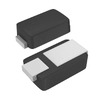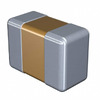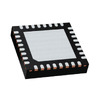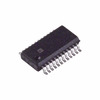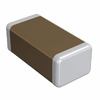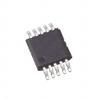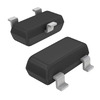How to Read Resistor Color Code?
This article explores the careful process of reading resistor codes, a skill that boosts the accuracy of circuit design, eases repairs and maintenance, and ensures high-quality standards. Resistor color coding, a system using color bands to show resistor values, is a valuable tool for electronics pros and hobbyists. By figuring out these colors, which stand for numbers, multipliers, tolerances, and temperature changes, people can make sure electronic devices work properly, from simple gadgets to complex machines.
Catalog
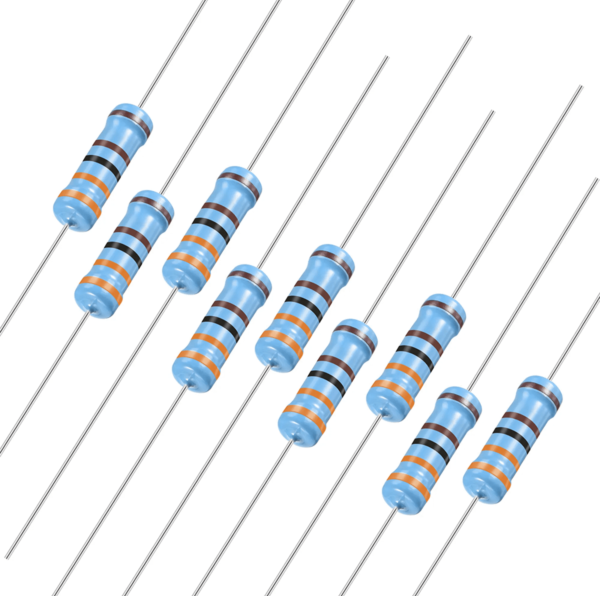
Figure 1: Resistors
Importance of Reading Resistor Codes
Using the wrong resistors can make the circuit work badly or even cause damage. Knowing how to read these codes ensures the correct resistors are used, keeping the circuit functional and safe.
For students and beginners, learning to read resistor codes is a basic skill. It teaches the basics of circuit building and how different component values affect circuit behavior, giving a strong foundation in electronics.
Identifying the Color Bands

Figure 2: Resistors Color Bands
Resistors usually have four or five colored bands. Here’s what the different color bands on a resistor mean.
First Two Bands: These bands show the main numbers of the resistor's value. Each color stands for a number from 0 to 9.
Third Band: This band tells you how many zeros to add to the main numbers.
Fourth Band: This band shows how much the actual resistance can vary from the stated value.
Fifth Band (If Present): This band can mean two things, refined tolerance and temperature coefficient.
The Values of the Colored Bands
Main Numbers (Significant Digits)
The first two or three bands are the main numbers of the resistor's value. Each color stands for a number:
|
Color |
Value |
|
Black |
0 |
|
Brown |
1 |
|
Red |
2 |
|
Orange |
3 |
|
Yellow |
4 |
|
Green |
5 |
|
Blue |
6 |
|
Violet |
7 |
|
Grey |
8 |
|
White |
9 |
Table 1: Resistor Colors and Values
Multiplier
|
Color |
Value |
|
Black |
×1 |
|
Brown |
×10 |
|
Red |
×100 |
|
Orange |
×1,000 |
|
Yellow |
×10,000 |
|
Green |
×100,000 |
|
Blue |
×1,000,000 |
|
Gold |
×0.1 |
|
Silver |
×0.01 |
Table 2: Resistor Colors and Value Multiplier
Tolerance
|
Color |
Value |
|
Brown |
±1% |
|
Red |
±2% |
|
Green |
±0.5% |
|
Blue |
±0.25% |
|
Violet |
±0.1% |
|
Grey |
±0.05% |
|
Gold |
±5% |
|
Silver |
±10% |
|
No Band |
±20% |
Table 3: Resistor Colors and Tolerance Values
Quick Reference Table
|
Color |
Digit |
Multiplier |
Tolerance |
|
Black |
0 |
1 |
N/A |
|
Brown |
1 |
10 |
±1% |
|
Red |
2 |
100 |
±2% |
|
Orange |
3 |
1,000 |
N/A |
|
Yellow |
4 |
10,000 |
N/A |
|
Green |
5 |
100,000 |
±0.5% |
|
Blue |
6 |
1,000,000 |
±0.25% |
|
Violet |
7 |
N/A |
±0.1% |
|
Grey |
8 |
N/A |
±0.05% |
|
White |
9 |
N/A |
N/A |
|
Gold |
N/A |
0.1 |
±5% |
|
Silver |
N/A |
0.01 |
±10% |
Table 4: Values of the Colored Bands
Resistor Color Code Chart
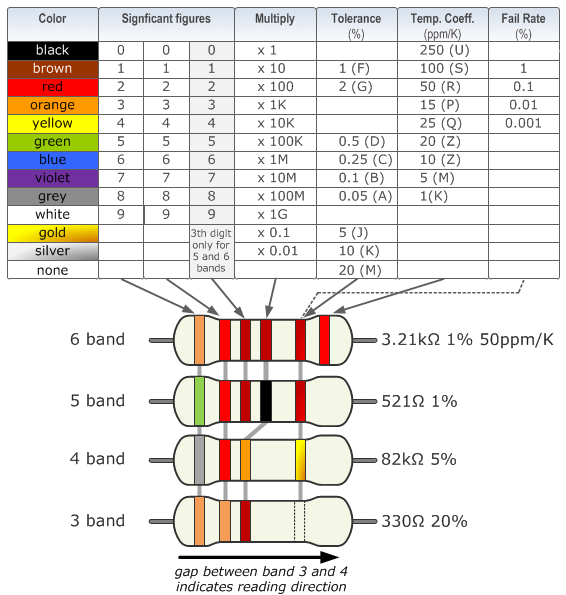
Figure 3: Resistor Color Code Chart
6-Band Resistor Color Code
The 6-band resistor color code is more precise than the simpler 3-band and 4-band systems. It uses the first three bands for significant digits and the remaining bands for the multiplier, tolerance, and temperature coefficient. Here’s an easy guide to reading these codes and calculating resistance:
Look at the colors of first three bands and use a resistor color code chart to find their numerical values;
Check the color of fourth band to find the multiplier, which tells you how many zeros to add to the digits;
You can calculate resistance using this formula:
Resistance (Ω) = (1st digit × 100 + 2nd digit × 10 + 3rd digit) × Multiplier
Fifth Band (Tolerance): Shows the accuracy of the resistor’s value, indicating how much it might vary from the stated value;
Sixth Band (Temperature Coefficient): Shows how much the resistance changes with temperature.
Example
Let's use a 6-band resistor with the following color sequence: Green, Blue, Black, Orange, Violet, Red.

Figure 4: A 6-Band Resistor
|
Color |
1st
Band |
2nd
Band |
3rd
Band |
4th
Band Multiplier |
5th
Band Tolerance |
6th
Band Temp. Coeff. |
|
Black |
0 |
0 |
0 |
×1 |
- |
- |
|
Brown |
1 |
1 |
1 |
×10 |
±1% |
100ppm/K |
|
Red |
2 |
2 |
2 |
×100 |
±2% |
50ppm/K |
|
Orange |
3 |
3 |
3 |
×1,000 |
- |
15ppm/K |
|
Yellow |
4 |
4 |
4 |
×10,000 |
- |
25ppm/K |
|
Green |
5 |
5 |
5 |
×100,000 |
±0.5% |
- |
|
Blue |
6 |
6 |
6 |
×1,000,000 |
±0.25% |
10ppm/K |
|
Violet |
7 |
7 |
7 |
×10,000,000 |
±0.10% |
5ppm/K |
|
Grey |
8 |
8 |
8 |
×100,000,000 |
±0.05% |
- |
|
White |
9 |
9 |
9 |
×1G |
- |
- |
|
Gold |
|
|
|
×0.1 |
±5% |
- |
|
Silver |
|
|
|
×0.01 |
±10% |
- |
Each color on a resistor corresponds to a specific number. For our example, let's consider the following color bands:
Green: 5
Blue: 6
Black: 0
Orange (Multiplier): x1,000
Violet (Tolerance): ±0.1%
Red (Temperature Coefficient): 50 ppm/°C
The first three colors represent significant digits. Combine these digits to form a number:
Green (5)
Blue (6)
Black (0)
Combining these, we get the number 560.
Next, apply the multiplier from the fourth color band. In this case, Orange indicates a multiplier of 1,000. Multiply the combined significant digits (560) by this multiplier:
560 × 1,000 = 560,000
So, the resistance value is 560,000 ohms or 560 kΩ.
Tolerance indicates how much the actual resistance can vary from the nominal value. The fifth color band, Violet, signifies a tolerance of ±0.1%. This means the resistor’s actual resistance can vary by ±0.1% from 560,000 ohms.
560,000 × 0.001 = 560
560,000 ± 560
So, the resistance can range from 559,440 Ω to 560,560 Ω.
The sixth color band, Red, represents the temperature coefficient, which is 50 ppm/°C. This means the resistance changes by 50 parts per million per degree Celsius.
Here's the complete specification for our resistor:
• Resistance: 560,000 Ω (or 560 kΩ)
• Tolerance: ±0.1%
• Temperature Coefficient: 50 ppm/°C
5-Band Resistor Color Code
You can easily decode any 5-band resistor and accurately determine its resistance value by following these steps:
Start by looking at the first three color bands on the resistor. These bands represent the significant digits of the resistance value. Use a resistor color code chart to match each color to its corresponding number;
Find the color of the fourth band. This band indicates the multiplier, which tells you how many zeros to add to the number formed by the first three bands. In other words, it shows the power of ten you need to multiply by;
Next, use this formula to find the total resistance:
Resistance (Ω) = (1st digit value × 100 + 2nd digit value × 10 + 3rd digit value) × Multiplier
This combines the values from the first three bands and multiplies them by the fourth band's value to get the resistance in ohms (Ω);
Finally, look at the color of the fifth band. This band indicates the tolerance, or how accurate the resistor's resistance value is. It tells you the percentage by which the actual resistance can vary from the calculated value.
Example
Let's use a 5-band resistor with the following color sequence: Yellow, White, White, Black, and Brown.

Figure 5: 5-Band Resistor
|
Color |
1st
Band |
2nd
Band |
3rd
Band |
4th
Band Multiplier |
5th
Band Tolerance |
|
Black |
0 |
0 |
0 |
×1 |
|
|
Brown |
1 |
1 |
1 |
×10 |
±1% |
|
Red |
2 |
2 |
2 |
×100 |
±2% |
|
Orange |
3 |
3 |
3 |
×1,000 |
|
|
Yellow |
4 |
4 |
4 |
×10,000 |
|
|
Green |
5 |
5 |
5 |
×100,000 |
±0.5% |
|
Blue |
6 |
6 |
6 |
×1,000,000 |
±0.25% |
|
Violet |
7 |
7 |
7 |
×10,000,000 |
±0.10% |
|
Grey |
8 |
8 |
8 |
×100,000,000 |
±0.05% |
|
White |
9 |
9 |
9 |
×1G |
|
|
Gold |
|
|
|
×0.1 |
±5% |
|
Silver |
|
|
|
×0.01 |
±10% |
Table 6: 5-Band Resistor Color Code
First, identify the color code values for each band.
First Band (Yellow): 4
Second Band (White): 9
Third Band (White): 9
Fourth Band (Black): Multiplier of 1 (since black corresponds to a multiplier of 100)
Fifth Band (Brown): Tolerance of 1%.
Next, take the digits from the first three bands and combine them to form a number. In this case:
Yellow: 4
White: 9
White: 9
This gives us the number 499.
Now, multiply this number by the value indicated by the fourth band. Here, the fourth band is black, which means a multiplier of 1. So, the calculation is:
Resistance = 499 × 1 = 499Ω
The fifth band gives us the tolerance, which in this case is 1% (brown). To find this range, calculate 1% of 499 Ω:
1% of 499Ω = 1/100 × 499 = 4.99Ω
Now, determine the possible range by adding and subtracting this value from the original resistance:
Minimum Resistance: 499 Ω − 4.99 Ω = 494.01 Ω
Maximum Resistance: 499 Ω + 4.99 Ω = 503.99 Ω
So, the resistor can have a value between 494.01 Ω and 503.99 Ω.
Band Resistor Color Code
Figuring out the total resistance of a 4-band resistor is straightforward if you follow these simple steps.
Start by looking at the first two colored bands on the resistor. Each color stands for a number, which you can find on a resistor color code chart;
After you have these numbers, check the third band to find the multiplier. This tells you how many zeros to add to the first two digits;
Use this formula:
Resistance (Ω) = (1st digit value x 10 + 2nd digit value) x Multiplier
Finally, the color of the fourth band shows the tolerance level, which tells you how much the actual resistance can vary from the stated value. This method helps you calculate a resistor's total resistance accurately.
Example
Let's use a 4-band resistor with the following color sequence: Yellow, Violet, Brown and Silver

Figure 6: 4-Band Resistor
|
Color |
1st
Band |
2nd
Band |
3rd
Band Multiplier |
4th
Band Tolerance |
|
Black |
0 |
0 |
×1 |
|
|
Brown |
1 |
1 |
×10 |
±1% |
|
Red |
2 |
2 |
×100 |
±2% |
|
Orange |
3 |
3 |
×1,000 |
|
|
Yellow |
4 |
4 |
×10,000 |
|
|
Green |
5 |
5 |
×100,000 |
±0.5% |
|
Blue |
6 |
6 |
×1,000,000 |
±0.25% |
|
Violet |
7 |
7 |
×10,000,000 |
±0.10% |
|
Grey |
8 |
8 |
×100,000,000 |
±0.05% |
|
White |
9 |
9 |
×1G |
|
|
Gold |
- |
- |
×0.1 |
±5% |
|
Silver |
- |
- |
×0.01 |
±10% |
Table 7: 4-Band Resistor Color Code
The first two color bands on a resistor indicate its base value.
First band is Yellow, which equals 4. Second band is Violet, which equals 7.
When we put these two numbers together, we get 47. So, our base value is 47.
Now, we move on to the third band, the multiplier, which tells us what to multiply our base value by. In our case:
Brown represents a multiplier of 10.
Now, we multiply our base value of 47 by 10:
47 × 10 = 470
So, the resistance value of our resistor is 470 ohms.
Finally, we have the fourth band, which tells us about the tolerance—how much the actual resistance can vary from the specified value.
The fourth band is Silver, which represents a 10% tolerance.
This means the actual resistance can vary by ±10% from the nominal value. To find the tolerance range, we calculate 10% of 470 ohms:
470 × 0.10 = 47
So, the actual resistance could be as low as:
470 − 47 = 423 ohms
Or as high as:
470 + 47 = 517 ohms
We've decoded our resistor's value and tolerance:
• Base Value: 47
• Multiplier: 10
• Resistance: 470 ohms
• Tolerance: ±10% (423 to 517 ohms)
Reading Errors and Tips to Avoid Them
Misidentification of Colors
Poor lighting or subtle color variations can cause misreading of resistor color bands. Ensure your work area has high-quality LED lighting or daylight bulbs to enhance color visibility. Use a magnifying glass for small or closely spaced bands to see colors more clearly and accurately.
Incorrect Order of Reading
Determining the correct end to start reading the resistor from can be confusing. Start from the end of the resistor closest to the edge or the side opposite the tolerance band (usually gold or silver). If there is no tolerance band, begin where the bands are more densely packed. This approach prevents reading the sequence in reverse, which can drastically alter the resistance value.
Confusion Between Similar Colors
Similar colors like red, orange, and brown or green and blue can be easily confused, especially in poor lighting. Regularly practice the resistor color code sequence or keep a color code chart handy as a reference. Digital tools, such as mobile apps designed for resistor reading, can provide a double-check mechanism to ensure accuracy and compensate for common color misidentifications.
Impact of Color Blindness
Individuals with color vision deficiencies struggle to accurately read color-coded resistors. Use apps designed to help those with color blindness by adjusting color output for better differentiation. Alternatively, use electronic tools like multimeters to directly measure resistor values, bypassing the need for color identification and ensuring accuracy regardless of visual impairments.
Conclusion
Learning the resistor color code system is more than just figuring out what the colored bands mean. It’s about making sure electronic systems work well and reliably in many different uses. The detailed explanation helps people know how to accurately find resistor values in different setups, like three-band, four-band, or six-band systems. It also highlights the importance of being careful in electronic design and repair. As technology improves and the need for accuracy grows, being able to quickly and correctly read these codes becomes more important. Tips for avoiding common mistakes, like misreading colors or dealing with color blindness using digital tools and better lighting, show a thorough way of handling real-life challenges in electronics work. In short, the resistor color code system shows that getting the basics right leads to doing great work even in complex tasks, making sure devices not only meet but exceed performance and reliability standards.
Frequently Asked Questions [FAQ]
1. How to Remember the Resistor Color Code?
To effectively remember the resistor color code, you can use the mnemonic phrase "BB Roy of Great Britain had a Very Good Wife." Each letter stands for a color corresponding to a digit from 0 to 9:
Black = 0
Brown = 1
Red = 2
Orange = 3
Yellow = 4
Green = 5
Blue = 6
Violet = 7
Gray = 8
White = 9
This mnemonic helps you recall the order of the colors and their associated numerical values, aiding in quick resistor identification.
2. How Do You Solve a Resistor Color?
To determine the resistance value from a resistor’s color bands, follow these steps:
Identify the color of each band (four bands on common resistors).
Use the first two colors to find their corresponding numbers using the color code.
The third band is the multiplier, indicating the number of zeros to add.
The fourth band (if present) indicates the tolerance or accuracy of the resistor.
For instance, if the bands are red, violet, and orange, you would calculate 2 (red), 7 (violet), followed by three zeros (orange multiplier), resulting in 27000 ohms.
3. What is the Color Code for the 220 Ohm Resistor?
The color code for a 220-ohm resistor is:
Red (2)
Red (2)
Brown (multiplier of 10)
Therefore, it is Red-Red-Brown, representing 22 followed by one zero, equating to 220 ohms.
4. What is a Zero-Ohm Resistor?
A zero-ohm resistor is a jumper used for connecting traces on a circuit board. It appears like any other resistor but has a single black band, signifying zero resistance. Its primary function is to act as a placeholder or bridge within circuit designs, allowing for more flexible PCB layouts and easier automated assembly.
5. How Do I Know Which End of the Resistor to Start Reading From?
To correctly read a resistor:
Look for a gold or silver band; this is the tolerance band and should be at the right end as you read the colors from left to right.
If all bands are colored (with no metallic band), start reading from the end where the bands are closest together.
About us
ALLELCO LIMITED
Read more
Quick inquiry
Please send an inquiry, we will respond immediately.
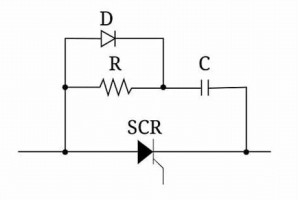
What Is a Snubber and Why Do You Need One in Your Electrical Systems?
on July 10th
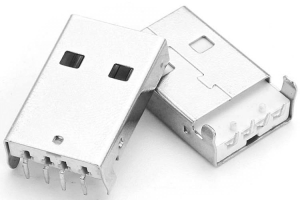
USB Type A Connectors & Pinouts
on July 9th
Popular Posts
-

What is GND in the circuit?
on January 1th 3278
-

RJ-45 Connector Guide: RJ-45 Connector Color Codes, Wiring Schemes, R-J45 Applications, RJ-45 Datasheets
on January 1th 2817
-

Understanding Power Supply Voltages in Electronics VCC, VDD, VEE, VSS, and GND
on November 20th 2646
-

Fiber Connector Types: SC Vs LC And LC Vs MTP
on January 1th 2268
-

Comparison Between DB9 and RS232
on January 1th 1885
-

What Is An LR44 Battery?
Electricity, that ubiquitous force, quietly permeates every aspect of our daily lives, from trivial gadgets to life-threatening medical equipment, it plays a silent role. However, truly grasping this energy, especially how to store and efficiently output it, is no easy task. It is against this background that this article will focus on a type of coin cell battery that may seem insignificant on the...on January 1th 1847
-

Understanding the Fundamentals:Inductance Resistance, andCapacitance
In the intricate dance of electrical engineering, a trio of fundamental elements takes center stage: inductance, resistance, and capacitance. Each bears unique traits that dictate the dynamic rhythms of electronic circuits. Here, we embark on a journey to decipher the complexities of these components, to uncover their distinct roles and practical uses within the vast electrical orchestra. Inductan...on January 1th 1810
-

What Is RF and Why Do We Use It?
Radio Frequency (RF) technology is a key part of modern wireless communication, enabling data transmission over long distances without physical connections. This article delves into the basics of RF, explaining how electromagnetic radiation (EMR) makes RF communication possible. We will explore the principles of EMR, the creation and control of RF signals, and their wide-ranging uses. The article ...on January 1th 1805
-

CR2430 Battery Comprehensive Guide: Specifications, Applications and Comparison to CR2032 Batteries
What is CR2430 battery ?Benefits of CR2430 BatteriesNormCR2430 Battery ApplicationsCR2430 EquivalentCR2430 VS CR2032Battery CR2430 SizeWhat to look for when buying the CR2430 and equivalentsData Sheet PDFFrequently Asked Questions Batteries are the heart of small electronic devices. Among the many types available, coin cells play a crucial role, commonly found in calculators, remote controls, and ...on January 1th 1803
-

Comprehensive guide to hFE in transistors
Transistors are crucial components in modern electronic devices, enabling signal amplification and control. This article delves into the knowledge surrounding hFE, including how to select a transistor's hFE value, how to find hFE, and the gain of different types of transistors. Through our exploration of hFE, we gain a deeper understanding of how transistors work and their role in electronic circu...on November 20th 1785



